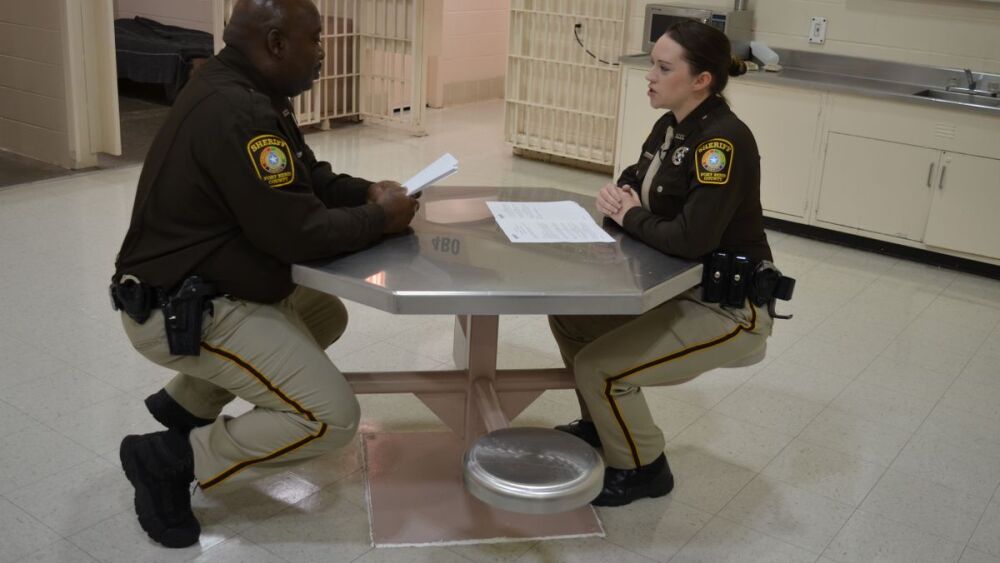The events of 2020 and 2021 illustrated how fragile race relations are in our country. The deaths of George Floyd, Breonna Taylor and Michael Brown during police encounters ignited strong feelings about law enforcement interactions with people of color.
Subsequent demonstrations featured calls to defund the police, abolish prisons, end police brutality. Systemic racism, critical race theory, white privilege and Black Lives Matter have become household terms.
While the conversation has evolved somewhat since the height of civil demonstrations in 2020, law enforcement — and correctional officers by extension — still find themselves accused of being racist.
Why focus on the events of the past two years in an article on cultural diversity training? Because those events have clearly demonstrated that our training needs to evolve.
Traditionally, cultural diversity training in corrections stressed sensitivity to people of different ethnic and race groups and the duty to avoid racial profiling. We learned things like, “Asian people tend to show less emotion” and “Mexican people are often quite religious” and “Filipinos come from a matriarchal culture so their relationships with their mothers are paramount.”
While such trainings are well meant, we need to do better. The civil demonstrations of 2020 and 2021 depicted just how deep racial tension lies — and how volatile it can be.
Avoiding racial bigotry in the jail is not enough; we must show the utmost professionalism and be skilled at developing mutual respect and de-escalating racial tension. Today, cultural diversity training in corrections has four goals:
- Understand the many race/ethnic groups represented in our offender populations.
- Apply the concepts of culture and diversity to the field of corrections.
- Learn effective ways to manage offenders from different ethnic and race groups.
- Understand how to avoid racial tension inside a correctional facility.
The Offender Population
The racial and cultural groups in your community will be represented in your inmate population. In 2020, the race makeup of our nation’s jails was:[1]
-
White: 47.7%
- Black: 35.1%
- Hispanic (Latino): 14.9%
- American Indian/Alaska Native: 1.2%
- Asian: 0.7%
- Native Hawaiian/Other Pacific Islander: 0.1%
- Two or more races: 0.3%
No discussion of race and ethnicity inside our nation’s correctional systems is complete without a look at the southern U.S. border and its problems. People from many nations enter the United States. The U.S. Border Patrol is unable to track all undocumented immigrants; some migrants are apprehended, some are not. Some of these migrants commit crimes and are arrested, landing in our nation’s jails — and not just at the border. In my jail career, I have encountered offenders from El Salvador, Mexico and other Latin America countries. I have also dealt with offenders from Cambodia, Vietnam and as far away as Ireland. Every jail is different, so it’s important to understand the groups you’ll encounter most often.
Culture and Diversity
America has been described as a “melting pot” — a nation of immigrants who assimilate into American culture. But the term is misleading. It implies immigrants don’t retain their cultural identity. Yet in most cities you’ll find Little Italy, Chinatown and other ethnic neighborhoods. And it’s not uncommon to find cultural and ethnic enclaves outside major cities, such as Burmese people in Battle Creek, Michigan, and Somalis in Minnesota. As a nation, we commemorate Cinco De Mayo, important to the history of Mexico, and Juneteenth, marking the end of slavery in the United States. We belong to one country, but we retain our unique cultural heritage.
Culture is defined as beliefs, habits, attitudes, values, patterns of thinking, behavior and everyday customs that have been passed on from generation to generation. Culture is learned, not inherited.[2] In a correctional facility, the culture of inmates may include their views of law enforcement, attitudes toward certain types of crime or types of offenders, and beliefs about rehabilitation.
No one is expecting correctional officers to be experts on the habits and customs of different ethnic and minority groups. However, officers should develop a general awareness of and sensitivity to cultural differences, including:[2]
- Eye contact: In some cultures, the lack of eye contact means respect.
- Facial expressions: Some cultures are more expressive of emotion and stress; others are more subdued or internalize stress.
- Distance: Americans, especially in law enforcement, like distance when we are speaking to someone. In some cultures, people prefer speaking to others at close distances.
- Gestures: Gestures that are innocent and friendly to one group can be offensive to another. Beckoning “come here” by curling the index finger with palm up may be offensive in the Asian and Latin American cultures. The meanings of gestures can also evolve quickly. In 2019, the Anti-Defamation League listed the “OK” hand gesture as a symbol of hate — although many of us grew up using it with no other meaning than, “all is well.”
- Body language: Parts of the body may evoke strong feelings. For instance, in many cultures, showing the soles of the feet is offensive, as feet are considered a dirty part of the body.
When we speak of culture, we cannot ignore what is learned. Anyone — correctional officers and inmates alike — can grow up learning animosity against a certain culture or ethnic group. For example, a person may be taught that “Black people are more inclined to commit crimes” or “Most Latinos are tied to illegal immigration or are here illegally.” Such beliefs are dangerous and will not support a positive climate inside a correctional facility. We must guard against ethnocentrism, the belief that your culture is the best and others are inferior.[2]
Diversity includes the vast range cultural differences that can influence the way we live and work together. Diversity means differences — and as correctional officers we must become comfortable interacting with people regardless of age, educational background, sexual orientation, gender, race, ethnicity and disability.[2]
The diverse populations of our jails create the need for correctional officers to navigate language difficulties, different styles of verbal and nonverbal communication, different religions and different views of law enforcement. Some inmates may identify closely with their “home country”; for others, this association will be more distant or negligible.
Cultural diversity training in corrections often focuses on inmates’ customs and culture — sort of a “thumbnail guide.” While these depictions of different cultures can be helpful, they risk oversimplifying diversity and promoting stereotypes. They also fail to account for the increasing number of people who identify as multiracial. Cultural diversity training should also discuss the diversity of the workforce. Correctional officers come from different ethnic and cultural groups. The respect we show for differences among offenders should extend to our colleagues as well.
Managing Offenders
Every correctional officer wants a smooth shift — one where correctional officers and inmates engage in mutual respect and tensions are minimal. But difference — diversity — can breed tension. So how does the correctional officer manage?
Following are some strategies to keep in mind:[3,4]
- Keep a level head: Your political and personal views — about illegal immigration, people of different races and cultural groups committing crimes, inmates not being able to speak English, and so on — have no bearing in the jail. Keep those views out of the workplace and don’t react when inmates and colleagues exhibit them. A correctional officer may complain, “They [foreign inmates] should know how to speak English.” Be realistic — what can you do about that? Nothing. Just do your job as best you can. Professionalism means neutrality. This goes across all cultural and racial lines.
- Keep the facility neutral: Just as you must keep your own views to yourself, the facility must remain free of symbols that have the potential to pit one ethnicity against another, no matter the race. Confederate flags, Antifa signs and Black Power posters have no place in the jail, regardless of the discussion we could have around what they mean and their historical significance.
- Cultivate curiosity: Racial profiling is not only illegal; it is a narrow way of thinking. Bigotry lumps people of a race or ethnic group into categories of criminal behavior. Not all Latinos are undocumented immigrants, not all young Black men are street thugs, and not all whites are redneck racists. Instead of falling for these stereotypes, strive to be open-minded. Ask questions about customs and beliefs. Seek to understand, not to judge.
- Pay attention to how they treat you: Attitudes toward law enforcement and authority figures vary widely across cultures. While basic jail rules of interaction must always be followed, paying attention to how inmates interact with you can provide clues for how to better connect with them and influence their behavior.
- Watch for signs of culturally related suicide risk or violence: The “shame factor” in many cultures around being arrested and charged with a crime can lead to depression and even suicidal ideation. Conversely, cultural norms can lead some inmates to react violently to anyone they perceive as disrespecting them.
- Know how to access interpretive services: Language barriers can perpetuate misunderstandings and set up inmates to be harassed. Every facility should have access to interpretive services. Know what’s available and how to use it — and don’t make inmates feel ashamed for having to communicate through an interpreter.
As with most challenges in the jail, training helps. Instructors should present scenarios detailing incidents of racial tension — some initiated by staff and others by inmates — and use class discussion to generate strategies of how to handle the situation. Such discussions can help correctional officers see how others interpret their words and actions and can empower them to de-escalate situations involving racial tension between inmates.
Avoiding Racial Tension Inside the Correctional Facility
Racial tension is not uncommon in correctional facilities. Often, it reflects what’s happening in the community or the nation. Inmates watch the news and learn about current events from family and friends. Tensions that exist on the street concerning racial groups and police can spill over into the jail.
Most inmates just want to do their time and go home. But some inmates like to push our buttons. They may play the race card: “You’re making me do this because I’m Mexican.” Be careful not to fall into this trap, lose your cool and increase the tension. Correctional officers will always encounter inmates who accuse them of unprofessionalism and mistreatment. Counteracting this and remaining professional in duties and comportment must be part of cultural diversity training in corrections at both the recruit and in-service levels.
While you may not be able to diffuse all racial tension in your facility, you can avoid contributing to it. It’s really not that complicated. First, treat all inmates with respect and dignity. And yes, I know they often do not treat you the same. But you are a professional correctional officer — act like it.
Second, avoid the usage of derogatory terms and racial slurs. This should be obvious, but sometimes correctional officers are tempted to use the same language inmates do. Such language not only makes you look unprofessional, it risks angering inmates and can create a harassing environment for staff. Do you want tension on your post or in your unit? Throw around the “N word” or call people other bigoted terms. Your smooth shift and any respect you seek will be gone. Do you want tension with staff of different ethnic groups? Act like a bigot. Note: Supervisors who see or hear of this behavior by staff have a duty to take corrective action.
Finally, when communicating with inmates from diverse cultures and races, there are some dynamics to be aware of. It is advisable to not:[2]
- Use language or mannerisms trying to be one of them. It appears phony and plastic. Examples include a white correctional officer walking up to Black officer or inmate and saying, “What’s up, bro?” Or an officer approaching a Native American inmate and saying, “Hey! I am Native American, too! My great-great-great uncle on my mother’s side was one-eighth Cherokee.” Just be yourself; do not walk on eggshells and overcompensate. Inmates, like most people, appreciate sincerity.
- Use phrases such as “Some of my best friends are [Black, Asian, Hispanic, etc.].” Two things are apparent: You are naïve, and you may hold prejudices. Another phrase to avoid is “you people.” It is stereotypical and bigoted.
- Argue with an inmate when they say such things as, “You are only writing me up because I am [Black, white, etc.].” Deflect such remarks by telling the inmate clearly why you are taking the course of action. Stating, “I am writing you up because you disobeyed a direct order, or you did not clean your cell, etc.,” is clear, quick and nonjudgmental. By doing so, you are avoiding the race trap the inmate is trying to set. Calmness is key.
Focus on Behavior, Not Color or Culture
When I retired from the jail, I was asked what I’d learned. One of the things that came to mind immediately is that good and bad comes in all races and ethnic groups. How good people are depends on the character of their hearts, not the color of their skin — as Dr. Martin Luther King said.
Cultural diversity training in corrections can no longer be limited to lumping people into groups and memorizing characteristics and customs associated with them. Our society is more diverse than ever and making assumptions is dangerous. Instead, training should focus on how to build respect with people of all backgrounds and perspectives and how to de-escalate situations when racial tension rises. Above all else, be yourself and be professional. Keep politics out of the workplace and treat inmates by the way they act, not according to the color of their skin.
References
1. Minton TD and Zhen Z. (2021) Jail Inmates in 2020 – Statistical Tables. Bureau of Justice Statistics. Accessed 6/4/22 from https://bjs.ojp.gov/library/publications/jail-inmates-2020-statistical-tables.
2. Shusta R, Levine D, Olson A. et al. (2015) Multicultural Law Enforcement: Strategies for Peacekeeping in a Diverse Society, Sixth Edition. Upper Saddle River: Pearson Prentice Hall.
3. Cornelius G. (2022) Jail: A Melting Pot of Cultures. Conference Presentation. Virginia Association of Regional Jails.
4. Cornelius G. (2019) Cultural Diversity Training: Achieving the “Smooth Shift.” The Corrections Connection. Accessed 6/4/22 from http://garycornelius.corrections.com/?p=287.
NEXT: How to establish strong relationships with subordinates














